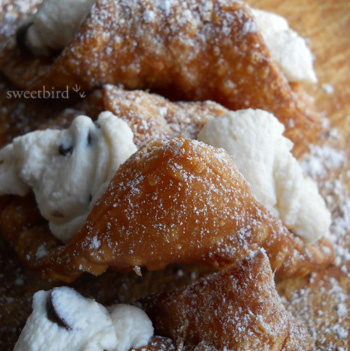
It all started when Angelo put ricotta on the shopping list because he likes to have it on pasta sometimes and we didn't have any in the house. I was the one doing the shopping that day, a day or two prior to Easter, and I found the ricotta on sale, with the large tub marked at a lower price than the small tub. So the large tub went in my basket, and then my mind started dreaming about what I was going to do with all that lovely ricotta.
Cannolis turned out to be the answer. I married into an Italian family from the New York City area, and that automatically means that in my lifetime I've eaten a lot of the best cannolis in the world. Since we moved to the country north of the city, we haven't had easy access to all the special things that city people accept as their birthright -- the best bagels, the best pizza and the best cannolis (to name just a few). The cannolis up here are pale, lifeless, overly-sweetened imposters.
So . . . I consulted all my resources and came up with a recipe for shells and filling and made some cannolis on Easter day. I gave myself a mediocre grade that day, even though we both loved the shells and loved the idea of having homemade cannolis (and Angelo sweetly never gives my efforts anything less than flying colors...). But I knew I could do better, so the next day I did more research and picked up some mascarpone, and then I think I hit the jackpot, or at least close enough to make us very happy.
It turns out that regular ricotta is not what you are getting when you buy a cannoli from a high-end shop or restaurant. They're using a special type of ricotta called impastata. It's creamier but at the same time drier than what you find at most markets, and it's used for all sorts of Italian specialties, savory and sweet. I asked around and found out I could place a special order with a local cheese shop, but since I realized I was spinning away from the original idea of using up all the ricotta I had bought, I tried a different strategy. And I think it came out very well, so here's what I did. I drained some ricotta in a fine sieve in the refrigerator for about 8 hours, then beat it thoroughly with the whisk in my KitchenAid to approximate the creamy texture of the impastata, and once it was beaten into submission I added some mascarpone. We thought it was great.
SHELLS (recipe from Chef Anne Burrell, with slight changes):
1½ C. AP flour (I used King Arthur unbleached)
1 Tbs. sugar
½ tsp. ground cinnamon
Pinch of kosher salt
2 Tbs. cold butter, cut into pea-sized pieces
1 egg yolk
¼ C. marsala
¼ C. cold water (approx.)
Oil for deep frying
Pulse the flour, sugar, cinnamon & salt in the food processor to combine. Add butter & egg yolk and pulse until the mixture looks like grated cheese. Add the marsala and pulse to incorporate. Begin to add water in small amounts, pulsing between each addition, just until the dough forms a ball. You may not need all the water.
Knead for about 5 minutes, until silky and smooth. Form a flat disk and wrap in plastic wrap. Refrigerate at least 45 minutes.
Start heating your oil when you take the dough out after its resting period. It should reach 350°F - 375°F. Get your cooling rack ready for the finished shells.

Separate the dough into two pieces and put one piece back in the refrigerator, wrapped. Using a pasta roller (I used my Atlas), roll out the dough, starting at setting #1. I like to put it through a couple of times at that setting, folding it in between times, until it seems completely smooth. Use flour as needed to keep it from sticking on the rollers. When the dough comes out of the roller, handle it with your palms down (in other words, drape it over your knuckles) to avoid stretching it. Continue to roll it thinner and thinner until you have something no thicker than 1/8″. That should be about #5 on the dial (but next time I may try it one notch thinner, or roll it with a rolling pin before cutting into squares).

It can also be rolled by hand if you don’t have a pasta roller.
Cut into 3″ squares. I used a pizza cutter for this.

Put a metal cannoli tube across the center diagonally and moisten the tips with water or egg white before rolling together. Press slightly on the tips to ensure a good seal. Drop into hot oil and fry for several minutes until well browned. You can fry several at once, depending on the size of your fryer. Push the shells under the oil from time to time to achieve even browning. You’ll notice that the shell stops sending out moisture toward the end of frying; that's a clue that it's ready to come out. Drain on rack. Sprinkle with confectioner's sugar.

When cool enough to handle, remove the tube and use for the next batch. Since I only have four cannoli tubes, I needed a quicker turnaround, so I removed the hot tubes with rubberized pads and put them in the freezer for a minute to cool down.
Waiting to be filled:

FILLING (enough for about 4 cannolis):
About a cup of whole milk ricotta, drained at least 8 hrs.
(or ricotta impastata, if available; no need to drain)
1 tsp. Madagascar Bourbon vanilla
1 Tbs. confectioner’s sugar
3 Tbs. mascarpone
Chocolate chips or shaved chocolate (optional)
Whip the well-drained ricotta by itself for about 5 minutes on fairly high speed with a whisk in the KitchenAid. Add the vanilla and confectioner’s sugar and whisk briefly to blend. Add the mascarpone and whisk another 2 - 3 minutes. Stop frequently to scrape the sides down into the bottom with a spatula, and occasionally remove the whisk and shake out the filling that is stuck in the middle. Taste and adjust flavor.
Add dark chocolate bits. (I used Guittard dark chocolate chips.) Hold filling in the refrigerator until ready to serve the cannolis, then pipe into the shells from both sides with a pastry bag or plain plastic bag with a corner cut off.

Above is my second-day filling and below is a photo of my first-day filling. I think you can see the difference in texture. It is lumpy. I hadn't beaten it; just folded the ingredients together with a spatula. And it is brownish because I followed a recipe that added cinnamon to the filling. I won't do that again, because I think the flavor contrast with the shell was lost. A great cannoli has a gorgeous, creamy whiteness to it, and it's perfectly balanced against the flavor and texture of the shell. Here's what the first (much less successful) filling looked like:

The amounts for the filling are approximations. I played around with the flavor and texture until I liked what I had, then I reconstructed it into a recipe. The end result is very lightly sweetened, since that's what we like, but you may prefer to have a bit more sweetening in both the shells and the filling. It's all personal preference at that point. I like using confectioner's sugar because its fine texture disappears in the filling.
There are many ways to flavor a cannoli, including orange or lemon rind, liqueur, pistachios, etc., so it's something you can play with to suit your and your family's palate. In fact, since you shouldn't fill the shells until the last minute (so they don't get soggy), you can mix up a batch of the basic filling and then let everyone create their own filling variation and pipe it into the shells. Kids would love that.
I decided to make cannoli shells with just the first half of the dough. That gave me about 10 - 12 shells, which seemed more than enough for us. With the second half, I rolled out the dough as before but cut it into rough rectangles and dropped it in the hot oil, then sprinkled with confectioner's sugar. I think these would make great appetizers. Hardly any sweetness; just crispy, airy deliciousness. We liked having a few with wine as we were putting dinner together.


One day I'll try it with homemade ricotta, which I love more than any ricotta I've ever tasted!
Happy baking to all,
Janie


